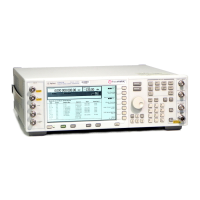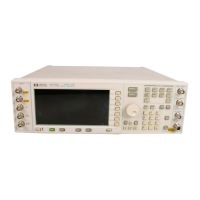500 Chapter 16
W-CDMA Uplink Digital Modulation for Receiver Test
Overload Testing with Multiple PRACHs—Multiple ESGs
Configuring the ESGs
1. Set up the multiple PRACH signal for both ESG 1 and ESG 2 using the procedures from “Setting Up a
Multiple PRACH Signal” on page 479. However, set each UE to a different signature, and turn on all
UEs.
You can vary the parameters between ESG 1 and ESG 2 for the multiple PRACH signals to obtain your
desired output.
2. Configure ESG 1 rear panel output trigger signals according to Table 16-2 on page 498.
3. Select the ESG input synchronization signal type.
a. On ESG 1, press
Link Control > PRACH Trigger Setup > Frame Trigger Setup >
Sync Source SFN FClk ESG to FClk.
b. On ESG 2 press
Link Control > PRACH Trigger Setup > Frame Trigger Setup >
Sync Source SFN FClk ESG to FClk or to ESG if you are using the ESG sync pulse signal.
This lets the ESG synchronize using the BTS frame clock signal. The ESG selection for ESG 2 enables
ESG 2 to synchronize with ESG 1. Since ESG 1 is synchronized with the BTS, this means that ESG 2
will also be synchronized with the BTS through ESG 1. The
Frame Trigger Setup softkey can also be
accessed from the top level W-CDMA softkey menu.
4. Set the frame synchronization trigger mode.
a. On ESG 1, press
Frame Sync Trigger Mode Single Cont to Cont.
b. On ESG 2, press
Frame Sync Trigger Mode Single Cont to Cont.
The single mode (Single) lets the ESG trigger off the first BTS frame pulse and ignores all subsequent
frame timing pulses. The continuous mode (Cont) enables the ESG to align its frame timing with each
BTS frame timing pulse.
5. Set the frame timing pulse interval.
a. On ESG 1, press
Frame Clock Interval > 10 msec, 20 msec, 40 msec, 80 msec, or 2560 msec.
b. On ESG 2, press
Frame Clock Interval > 10 msec, 20 msec, 40 msec, 80 msec, or 2560 msec.
The actual frame timing interval value is dependent on the BTS frame clock pulse interval and whether
or not the ESG frame synchronization trigger mode is set to single or continuous. If the ESG trigger
mode is continuous, then it is critical that the selection is a value that is less than or equal to the base
station frame pulse interval, or else the ESG will incur an out of synchronization condition with the BTS.
When this occurs, an Out Sync annunciator appears on the ESG. For example, if the BTS frame timing
was 20 ms and the ESG selection was
40 msec, an out of synchronization condition will occur. The
results of the example are shown in Figure 16-35. An ESG frame clock interval of 10 or
20 ms will resolve the out of sync condition. This applies to ESG 1 and ESG 2 if they are both directly
connected to the BTS frame timing interval signal. However, if ESG 2 is synchronized using the ESG

